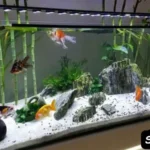marine life blog
Bio filter for aquarium
The underwater world of an aquarium, teeming with vibrant fish and intricate plants, is a captivating microcosm of life. But beneath the surface beauty lies a complex ecosystem that requires careful management to thrive. One crucial element in maintaining this delicate balance is the bio filter. This unsung hero, often hidden from view, plays a vital role in transforming harmful waste products into harmless substances, ensuring the health and longevity of your aquatic inhabitants. Let’s explore bio filter for aquarium with fishtankmagic.com in the article below!
Understanding the bio filter for aquarium: A Foundation of Aquarium Health
The bio filter, in essence, is a carefully designed system that harnesses the power of beneficial bacteria to break down ammonia, nitrite, and nitrate – the toxic byproducts of fish waste and decaying organic matter. These bacteria, known as nitrifying bacteria, are microscopic but mighty, playing a crucial role in the natural nitrogen cycle that governs the health of any aquatic environment.
The process begins with the breakdown of ammonia, a highly toxic compound released by fish waste and decaying food. Nitrifying bacteria, specifically Nitrosomonas, oxidize ammonia into nitrite, a slightly less toxic compound. This conversion is the first step in a crucial chain reaction that renders the waste harmless.
The next stage involves the conversion of nitrite into nitrate, a far less toxic compound. This transformation is carried out by another group of nitrifying bacteria, Nitrobacter. Nitrate, while less harmful than ammonia or nitrite, can still accumulate to toxic levels if not adequately addressed. This is where the final stage of the bio filter comes into play, often involving plants or other methods to remove nitrate from the water column.
The Mechanics of a Bio Filter: A Symphony of Components
The bio filter itself is not a singular entity but rather a carefully orchestrated system of components that work in concert to achieve the desired outcome. The most common type of bio filter is the wet/dry filter, which utilizes a combination of wet and dry environments to maximize the surface area available for bacterial colonization.
1. The Wet Chamber:
This chamber is submerged in the aquarium water, creating a moist environment ideal for the growth of nitrifying bacteria. A variety of materials can be used in the wet chamber, each providing a different type of surface area for bacterial colonization. Common materials include:
- Ceramic rings: These porous rings offer a large surface area for bacterial growth and are highly effective in removing ammonia and nitrite.
- Bio balls: These spherical balls provide a large surface area and are often used in combination with other filter media.
- Sponge: This material provides a good surface area for bacterial growth and is particularly effective in trapping larger particles of debris.
2. The Dry Chamber:
This chamber is located above the water level, providing a dry environment for the bacteria to thrive. The dry chamber is typically filled with a material like lava rock or ceramic media that provides a large surface area for bacterial colonization. The dry chamber also allows for the evaporation of water, which helps to regulate the humidity and prevent the growth of harmful bacteria.
3. The Filter Media:
The filter media, whether in the wet or dry chamber, plays a crucial role in providing a suitable environment for the bacteria to flourish. The ideal filter media should be porous, providing a large surface area for bacterial colonization. It should also be inert, meaning it does not release harmful substances into the water.
4. The Water Flow:
The flow of water through the bio filter is essential for delivering oxygen and nutrients to the bacteria while also removing waste products. The flow rate should be sufficient to ensure that all of the filter media is adequately exposed to the water, but not so strong that it disrupts the bacterial colonies.
Types of Bio Filters: Adapting to Different Needs
While the wet/dry filter is the most common type, there are other bio filter designs available, each tailored to specific needs and aquarium setups.
1. Undergravel Filters:
These filters are placed beneath the gravel substrate, creating a space for water to flow through and be filtered. The filter media is typically housed in a series of plates or tubes, providing a large surface area for bacterial colonization. Undergravel filters are effective at removing waste products but can be difficult to clean and maintain.
2. Hang-On Filters:
These filters are attached to the side of the aquarium, offering a convenient and compact solution for filtration. They typically contain a combination of filter media, including sponge, ceramic rings, and activated carbon. Hang-on filters are easy to maintain and provide adequate filtration for smaller aquariums.
3. Canister Filters:
These filters are external units that are connected to the aquarium via hoses. They offer a high level of filtration capacity and are particularly suitable for larger aquariums. Canister filters typically contain a variety of filter media, including sponge, ceramic rings, bio balls, and activated carbon.
4. Internal Filters:
These filters are submerged within the aquarium and are often used in smaller tanks. They typically contain a sponge and a ceramic ring media, providing basic filtration for smaller aquariums.
The Importance of Cycling: Establishing a Healthy Bio Filter
Before introducing fish to a new aquarium, it is essential to cycle the bio filter. Cycling refers to the process of establishing a healthy population of nitrifying bacteria within the filter media. This process typically takes several weeks and involves gradually introducing ammonia to the aquarium water, allowing the bacteria to multiply and establish a stable population.
During the cycling process, it is important to monitor the levels of ammonia, nitrite, and nitrate in the water. Once the levels of ammonia and nitrite have dropped to zero, and the nitrate level is low, the bio filter is considered cycled and ready to support fish.
Maintaining a Healthy Bio Filter: A Continuous Process
Once the bio filter is established, it is important to maintain it regularly to ensure its continued effectiveness. This involves:
- Regular Cleaning: The filter media should be cleaned regularly to remove accumulated debris and prevent the buildup of harmful bacteria. However, it is important to avoid over-cleaning, as this can disrupt the beneficial bacteria population.
- Water Changes: Regular water changes are essential for removing accumulated waste products and maintaining water quality. Partial water changes should be performed weekly, replacing 10-20% of the water.
- Filter Media Replacement: The filter media should be replaced periodically, depending on the type of media and the frequency of cleaning.
The Bio Filter: A Cornerstone of Aquarium Health
The bio filter is an indispensable component of any healthy aquarium ecosystem. By effectively breaking down harmful waste products, it creates a clean and healthy environment for fish and plants to thrive. Understanding the principles of bio filtration and implementing proper maintenance practices will ensure the long-term health and enjoyment of your aquatic companions.












